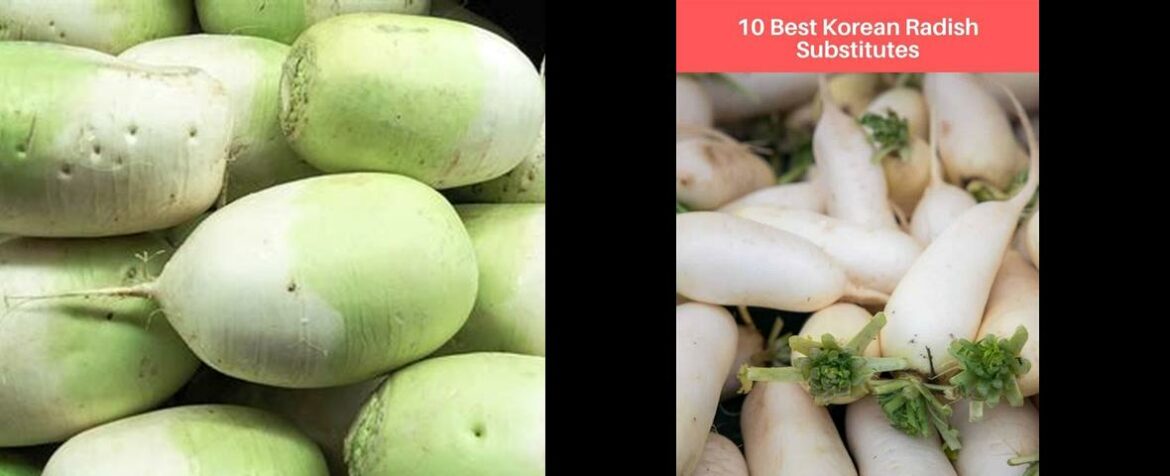Are you craving the bold flavors of authentic Asian cuisine but don’t have Korean radish on hand? Don’t fret! We’ve got you covered with this guide to finding the perfect Korean radish substitute. Whether you’re whipping up a batch of kimchi or adding a kick to your stir-fry, we’ll explore culinary adaptations that will make your taste buds dance with delight. So, let’s dive in and discover the secret to creating mouthwatering Asian dishes, even without the elusive Korean radish.
Korean Radish Substitute: Culinary Adaptations for Authentic Asian Delights
In the realm of Asian cuisine, Korean radish, renowned as “mu,” holds a prominent place as a versatile ingredient, gracing soups, stews, and pickled dishes with its distinctive flavor and texture. However, circumstances may arise when this culinary staple is unavailable, necessitating the exploration of suitable substitutes that can maintain the integrity of your culinary creations.
Daikon: A Mild-Mannered Stand-In
Daikon, a close relative of Korean radish, shares a similar elongated, white root structure and a mild, approachable flavor profile. Its versatility extends to various Asian culinary applications, making it a natural choice as a substitute. Whether you seek to replicate the crisp texture of Korean radish in a stir-fry or infuse your soup with a subtle radish essence, daikon stands ready to deliver.
Red Radish: A Peppery Twist
For those who crave a bolder flavor experience, red radish emerges as a compelling alternative. Its vibrant crimson hue adds a splash of color to your culinary canvas, while its peppery bite lends a piquant dimension to salads, garnishes, and other dishes. Red radish possesses a crunchy texture that remains distinct even after cooking, ensuring a satisfying sensory experience.
Indian Radish: Earthy Delights
Indian radish, also known as mooli, distinguishes itself with an earthy flavor and a crunchy texture that holds its ground even when subjected to heat. This robust vegetable finds its niche in stir-fries, soups, and stews, where it imparts a distinctive character that complements a wide range of ingredients.
Turnips: Subtle Sweetness and Versatility
Turnips, with their understated sweetness and firm texture, offer a versatile solution as a Korean radish substitute. Their adaptability extends to various cooking methods, from roasting and steaming to sautéing and boiling, making them a convenient choice for a multitude of dishes.
Cabbage Heart: A Surprising Culinary Gem
Cabbage heart, an unexpected yet delightful substitute for Korean radish, belongs to the Brassica family and possesses an edible flower. Its mild flavor, reminiscent of artichokes, seamlessly blends with various culinary creations. Steaming, boiling, or sautéing cabbage hearts unveils their tender texture and allows them to absorb the surrounding flavors, making them a versatile addition to your culinary repertoire.
Substituting with Confidence: Equal Measures and Nutritional Value
When incorporating these substitutes into your recipes, maintain a one-to-one ratio to ensure the desired flavor and texture balance. Rest assured that these alternatives not only replicate the culinary attributes of Korean radish but also boast their own nutritional merits. Daikon, red radish, Indian radish, turnips, and cabbage heart are all rich sources of vitamins, minerals, and fiber, contributing to a wholesome and balanced meal.
Adapting Substitutes to Suit Your Culinary Vision
While these substitutes provide a solid foundation for replicating the essence of Korean radish, feel empowered to adapt them to suit your unique culinary vision. Experiment with different cooking methods and flavor combinations to discover new dimensions of taste and texture. Embrace the opportunity to explore the culinary landscape and uncover hidden gems that elevate your dishes beyond mere substitution.
With a pantry stocked with these versatile Korean radish substitutes, you possess the culinary prowess to navigate any ingredient scarcity and continue crafting authentic Asian delights that tantalize taste buds and transport your diners to the heart of Asian culinary traditions.
FAQ about Korean Radish Substitute
Q: What is Korean radish and why is it important in Asian cuisine?
A: Korean radish, also known as “mu,” is a versatile ingredient that is commonly used in soups, stews, and pickled dishes in Asian cuisine. It adds a distinctive flavor and texture to these dishes, making it an important culinary staple.
Q: What can I use as a substitute for Korean radish?
A: Daikon, red radish, Indian radish, turnips, and cabbage heart can all be used as substitutes for Korean radish. These alternatives provide a similar flavor and texture to Korean radish and can be used in a one-to-one ratio in recipes.
Q: How can I adapt these substitutes to suit my culinary vision?
A: You can experiment with different cooking methods and flavor combinations to adapt these substitutes to your unique culinary vision. By exploring different techniques and ingredients, you can discover new dimensions of taste and texture in your dishes.
Q: Are these substitutes nutritionally beneficial?
A: Yes, these substitutes not only replicate the culinary attributes of Korean radish but also offer their own nutritional merits. Daikon, red radish, Indian radish, turnips, and cabbage heart are all rich sources of vitamins, minerals, and fiber, contributing to a wholesome and balanced meal.
Q: How should I use these substitutes in recipes?
A: When incorporating these substitutes into your recipes, it is recommended to maintain a one-to-one ratio to ensure the desired flavor and texture balance. This will help to maintain the authenticity of the dish while using the substitute.
Q: Can I use these substitutes in other Asian dishes?
A: Absolutely! These substitutes can be used in a variety of Asian dishes beyond Korean cuisine. Feel free to explore and experiment with these substitutes in other Asian recipes to create unique and delicious dishes.


